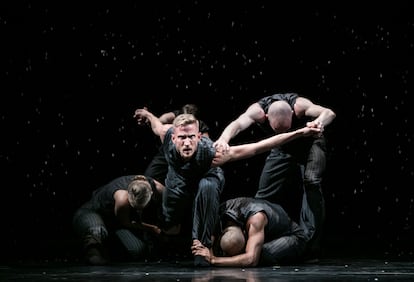Even today, some type of stage dance can be removed (or defended) from other dominant ones and be poetic, substantially poetry, in the aesthetic sense that Paul Valéry said in his essay on this topic, a text that, with everything and everything admires, has been handled excessively. As we know, dance and ballet have not had the governing apparatus of an aesthetics ordered and written accordingly (we do not have a Rameau in the art of Terpsichore). Valéry not only defends the height of dance as a magnificent art, but also calls for it to be taken seriously on its moral and theoretical bases. Watching the Swedish ballet performance, one can think how much dance needs today than Valéry wanted to assist it yesterday. It is about tomorrow, about preparing not only the body with a certain calisthenics, but also the spirit with which a danced work of art is received, and probably accepted.
The Göteborg company has changed a lot, it is completely different. And there continues to be seriousness, quality and polish both in the presentation of the choreographies and in the level required of the performers, who must navigate very different styles of movement and dynamics, from the individual to the group. There is something of a laboratory, of an alchemical workshop in these groups historically linked to opera houses that, at a gallop, want to climb to the future that is in front of them, but always far away (Petrarch glimpsed it when he imagined climbing Mont Ventuoux: where you only reach a second late, because the law of time is always preparation, as in dance).
The two choreographers chosen for this program are not as different from each other as they are made out to be. Each one, in its own and particular course, acts from the inside out, causing an ignition of the breathed accent, expressively, to deliver intense choreographic material that is ultimately almost romantic. This is not a conventional lyrical flight, but romanticism as it is filtered today through materials insensitive to emotion, such as titanium and silicon (previously it was steel and aluminum) but without which we cannot live.
Yoann Bourgeois (Jura, France, 1981) is a restless boy who comes from the circus and is in the circus, playing his proposals with a certain “lyrical imbalance” in the words of a French critic that portray his poetics quite well, always assisted by a a certain self-confidence and lack of inhibition, an unexplained rejection of the past, from which, in substance and form, we all structurally live. Bourgeois, today still dragged by the turbulent tail of the comet of plagiarism accusations that began in 2021 and continues to this day, continues to show that perhaps the world of dance entertainment needs its own #MeToo, because as he expressed at the time Liberation “The borders between homage, citation and plagiarism are among the thinnest that exist.”
The work seen in Pozuelo resembles many things at the same time in the drawing and in the dynamics, it lives and progresses from its choral effectiveness, which is not bad, but it is not the whole story. Most of the time we are carried away by the powerful music of Félix Lajkó (Backa Topola, Serbia, 1974) with his violin of Serbian and Hungarian genes, always tense and vibrant (his performances with Min Tanaka and his butoh dance sessions are legendary) ; It is that mournful and extreme chord that gives the tone to We Loved Each Other So Much, executed on a special pneumatic floor, specially designed after the experiences of artistic gymnastics floor platforms and other surfaces used in acrobatics. Bourgeois has already used these docks for other works, and they have their impact, limited, but impact nonetheless.
Crystal Pite (Terrace, Canada, 1970) offers in this program Just Echoa work that has come and gone from Europe to America more than once. It was created in The Hague with the Nederlands Dans in 2012, revived for the first time in Chicago with the Hubberd Street Dance in 2015, and again in Europe, this time in Venice in 2021 with the young people of the College de la Biennale. Just Echo is inspired by a poem by Mark Strand (1934 -2014), a great poet who in the poem Lines for Winter He gives us a verse that draws the choreographic work: “Gray falls from the air.”
In Just Echo a light and silent snow accompanies the seven dancers in that kind of Winter trip particular where it is not Schubert, but Brahms who fulfills the function of catalyst. There is still another verse from Strand, in another poem that, like Valéry, synthesizes and encloses the very core canon of dance: “Why do I love what flees?” This line can be the argument of Pite’s choreography, sensitive to encounter and detachment, to the corporeal vibration of the collision of bodies and its lament supplied by an evocative melodic tract. A beauty of a dance work that gains over time and that the artists of the Swedish company free from formality in their nocturnal atmosphere.
We will surely have more identity questions for Bourgeois than for Pite. It stands to reason. Choreography is a cumulative art of maturity that distills, through craft, inspiration and discarding both success and error. As in all arts, there are cases of early prodigies, but they are rare, often deceptive, and that is seen in the works, in the product. The public filled the Mira and warmly applauded the cosmopolitan and virtuous staff.
Gothenburg Opera’s Dance Company
Choreographies:
We Loved Each Other So Much: Yoann Bourgeois, música: Félix Lajkó.
Solo Echo: Crystal Pite, music: Johannes Brahms.
artistic director: Katrin Hall.
Autumn Festival of the Community of Madrid. Mira Theater, Pozuelo de Alarcón. November 29.

